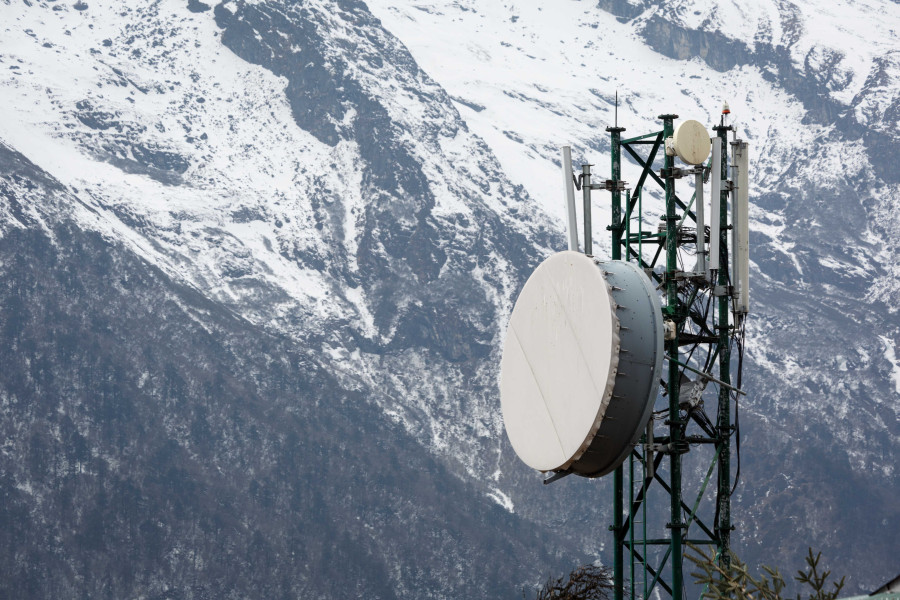Money
Nepalis pay more for internet than other South Asians, report says
A Nepali spends 2.6 percent of their gross annual income to buy internet service while in India, Sri Lanka and Pakistan, the cost is less than 1 percent.
Krishana Prasain
Nepalis pay more for internet access than other South Asians, a report has shown.
In 2020, a Nepali had to spend 2.6 percent of their gross annual income to buy internet service, which puts Nepal behind India, Sri Lanka and Pakistan in affordable digital access where the cost is less than 1 percent.
The gross national income of a Nepali stood at $1,191 in 2020.
According to the Connectivity in the Least Developed Countries Status Report, 2021 published by the International Telecommunication Union recently, broadband service in developing countries should not cost more than 2 percent of the gross national income per capita.
The report has highlighted that countries like Nepal need practical solutions to improve digital access, and should formulate concrete policy recommendations to accelerate progress towards universal and affordable connectivity.
This year’s report assesses the state of digital connectivity in the 46 United Nations-designated least developed countries (LDCs), and showcases practical solutions to improve digital access.
The report said that information and communication technologies (ICTs) can help countries leapfrog chronic development impediments in areas from education and health, to government services and trade.
ICT services make business more efficient and productive, opening the door to innovative services and applications that can fuel growth and trigger new business opportunities.
Mobile data prices have declined in all regions, but in the least developed countries, the cost is still seven times higher than the affordability target set by the United Nations, the report said.
Nepal has been using on average 2 GB data monthly in 2020, which is more than the International Telecommunication Union basket of 1.5 GB.
Purushottam Khanal, chairman of the Nepal Telecommunication Authority, said that the government was imposing taxes under different headings which has made internet service expensive.
"Besides, the internet infrastructure sharing plan has not been implemented," he said.
The Nepal Telecommunications Authority has rolled out the infrastructure sharing bylaw, which is expected to ease the financial burden on service providers and bring down costs.
Infrastructure sharing is a concept where several telecom companies use the same system like towers and fibre networks to provide their services, freeing them from having to build and invest in individual installations.
Currently, internet companies have to pay 2 percent rural telecommunication development fund tax, 4 percent royalty, 13 percent telecommunication service charge and import duty on telecommunications equipment.
“We have been frequently requesting the government to reduce taxes in the broadband sector. But there has been no response at all,” he said.
“As Nepal purchases broadband from India, there is cartelling by Indian internet sellers. We have been working to gain access to sea cable as a means to lower prices,” he said. “It’s not easy to bring down the cost of internet connection because of all these factors.”
Khanal said that encouraging the establishment of an assembly industry to produce telecommunication related products and waiving tax for information and technology related companies could bring down broadband service costs.
Nepal is in the "high" category among the least developed countries at different stages of digital development in improving indicators like households with mobile phones, mobile population coverage, mobile data price, and households with computer and internet use, according to the report.
Over 90 percent of households in Nepal have at least one family member with a mobile phone, the report said. Moreover, 96 percent of the households in Nepal have a mobile telephone among whom 97 percent are urban households and 94 percent are rural households.
The Sustainable Development Goal of the United Nations aimed to significantly increase access to information and communications technology and strive to provide universal and affordable access to the internet in the least developed countries by 2020.
Among the 85 percent of the proportion of individuals who own a mobile phone in Nepal, 79 percent are female and 91 percent are male, as per the report.
Internet service is like education in the least developed countries.
In 2019, out of the 41 percent surveyed female users, 16 percent females used the internet for productive skills like learning skills that can generate income, improve health and expand knowledge, the report said.
One challenge with developing productive digital skills is that most internet access in the LDCs is via mobile phone. Learning how to use a word processor or spreadsheet on a small screen is not ideal.
Computers are not widely available, with just an average of 8 percent of the households in the LDCs having one computer.
LDCs are far from reaching the penetration threshold to benefit from fixed broadband economic impacts, estimated to be around 10 fixed broadband subscriptions per 100 people.
The two closest are Bangladesh and Nepal, with a fixed broadband penetration of around 5 per 100 people, the report said.
In Nepal, 13 percent of the households have computers compared to the LDC average of 9 percent.
As per available data, awareness of e-commerce platforms is low in LDCs even among internet users. For instance, in Bangladesh, Cambodia and Nepal, less than a third of internet users were aware of goods e-commerce platforms such as Amazon, Alibaba or eBay.
According to the report, 7 percent of the internet users in Nepal carried out buying of goods and products online while 4 percent bought transport services, 7 percent bought tickets, 7 percent bought accommodation, 1 percent used it for hired help and 3 percent used it for micro work or freelance.
One challenge LDCs face in e-commerce development is lack of online shops. Buyers miss out on the convenience of shopping online, merchants have no online marketplace to sell goods, and lower-skilled people cannot gain employment in delivery services, which can be a route out of poverty, the report said.
Internationally recognised e-commerce brands can help to reduce the trust constraint, but few have invested in the LDCs. This limits options for merchants to sell online, and employment potential in logistics and other e-commerce-related occupations.
The report said many internet users in the LDCs were more familiar with social media than with the wider internet. There is a higher degree of trust when ordering through social media, since sellers are part of shopping groups or have been recommended by friends or family members who had positive experiences.
“In the vast majority of cases, cash on delivery is still the preferred mode of payment. This helps to partially overcome the lack of trust towards e-commerce in the LDCs, but it does not contribute to creating a level playing field and robust e-commerce ecosystem for both businesses and consumers,” the report said.
Digital skills training is a huge challenge. The report said that millions are not online in LDCs in part because they are not aware of the internet, or do not know how to use it. Equally challenging is the large number of people online but enclosed in a social media bubble.




 5.15°C Kathmandu
5.15°C Kathmandu















